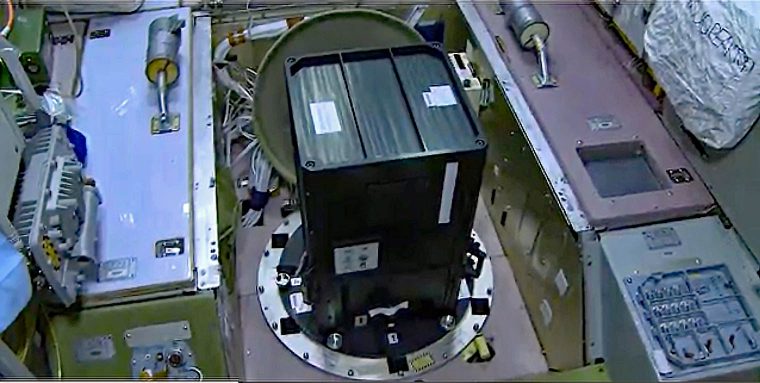 Mini EUSO, a first-of-its-kind cosmic UV telescope currently situated on the earth-facing window of the ISS, is housed by an entirely 3D printed structure
Mini EUSO, a first-of-its-kind cosmic UV telescope currently situated on the earth-facing window of the ISS, is housed by an entirely 3D printed structure
Using Stratasys FDM 3D printing in place of aluminum reduced production costs by a factor of ten, as well as saving close to one year in development time
Leading 3D printing solutions provider, Stratasys (Nasdaq: SSYS), today revealed its industrial-grade FDM 3D printing technology is being used to produce certified 3D printed parts for use on the International Space Station (ISS). As part of an ad hoc bilateral agreement between the Italian Space Agency (ASI) and the Russian Space Agency ‘Roscosmos’, Italian government research center, Istituto Nazionale di Fisica Nucleare (INFN – National Institute for Nuclear Physics) used its Stratasys Fortus 450mc FDM 3D Printer to produce the entire mechanical structure of a first-of-its-kind cosmic UV telescope currently situated aboard the ISS, realized under the coordination of the Italian Space Agency.
Designed to study terrestrial and cosmic UV emissions from the ISS, the telescope named ‘Mini-EUSO’ (Multiwavelength Imaging New Instrument for the Extreme Universe Space Observatory) was recently launched into space onboard a Soyuz rocket and successfully placed on an earth-facing window of the ISS’ Russian Zvezda module.
“With an orbit of about 90 minutes, Mini-EUSO records all space and atmospheric objects and events within sight, including UV emissions from night-earth, transient luminous events, meteors, space debris and more,” explains Marco Ricci, Lead Researcher at Laboratori Nazionali di Frascati INFN and INFN Country Manager for Collaboration EUSO SPB2 Italia. “The final scientific objective is to produce a high-resolution map of the Earth in the UV range (300-400 nm), which is expected to significantly advance research on cosmic rays, but also serve as an important experiment for future space missions.”
According to Ricci, the impact of 3D printing on this project has been transformational.
“Using Stratasys FDM 3D printing throughout the production of the Mini-EUSO’s mechanical structure enabled us to reduce the overall cost of the project by a factor of ten, as well as save us around a whole year of development time. It’s an incredible outcome for us that I have to say I never expected from 3D printing,” he says.
Producing the mechanical structure of Mini-EUSO presented several challenges. Most notably, the team needed a material that could meet the stringent certification requirements of the aerospace industry and the ISS, as well as bear the mechanical stress and vibrations of a rocket launch.
“We explored numerous ways in which we could achieve the expected performance while meeting material certification. We even built a full prototype in aluminum, one of the most commonplace materials for aerospace. But the results were far from expectation – the structure was too heavy and it did not provide the insulation required for the interior electrical currents,” explains Tommaso Napolitano, Head of Mechanics Design and Construction Department at INFN, Laboratori Nazionali di Frascati, Rome.
“As a result, we turned to our Fortus 450mc 3D Printer and found that the ULTEM™ 9085 resin offered the perfect alternative. Not only is the material extremely durable, but it’s lightweight. And crucially, it also offers exceptional insulation properties, as well as high chemical and thermal resistance. It’s fair to say that without the capability to print the Mini-EUSO structure in this material, we would not have met the ISS’ safety and weight restrictions.”
The Mini-EUSO project, coordinated and funded by ASI, has been developed by the JEM EUSO Collaboration (Joint Experiment Missions – Extreme Universe Space Observatory), a wider international program including France, Germany, Italy, Japan, Poland, Russia, Slovakia, Sweden, Switzerland and United States. The initiative aims to explore the origin and nature of ultra-high energy cosmic rays from space and will see the 3D printed Mini-EUSO telescope stay on the ISS for the next three years.
“We are now in the process of analysing the first data recorded by Mini-EUSO and the results are very promising. From a researcher’s perspective, I’m extremely proud of the way the project was executed and very excited with the achievements. For me it’s clear now how 3D printing can significantly contribute towards the future success and technological progress of scientific research,” concludes Ricci.
INFN is an Italian government research institute tasked with promoting, coordinating and conducting scientific research in nuclear, subnuclear and astroparticle physics. The Laboratori Nazionali di Frascati (LNF) branch is one of INFN’s four national research centers, who is also collaborating with major Italian universities as part of its research activities. At LNF, the team has several Stratasys FDM 3D Printers for its production work, the most recent of which is an additional Fortus 450mc from Stratasys’ local partner, CAD Manager, part of Energy Group. Additionally, the team recently introduced PolyJet 3D printing for the first time to further boost its design work.
www.stratasys.com


















































































